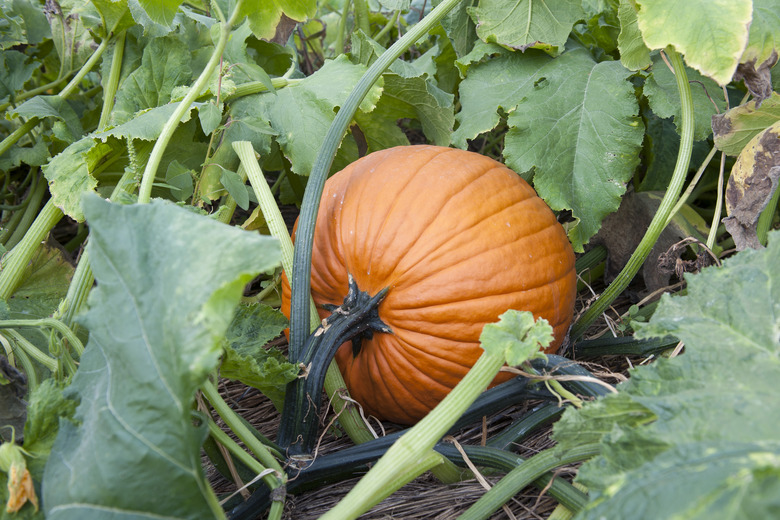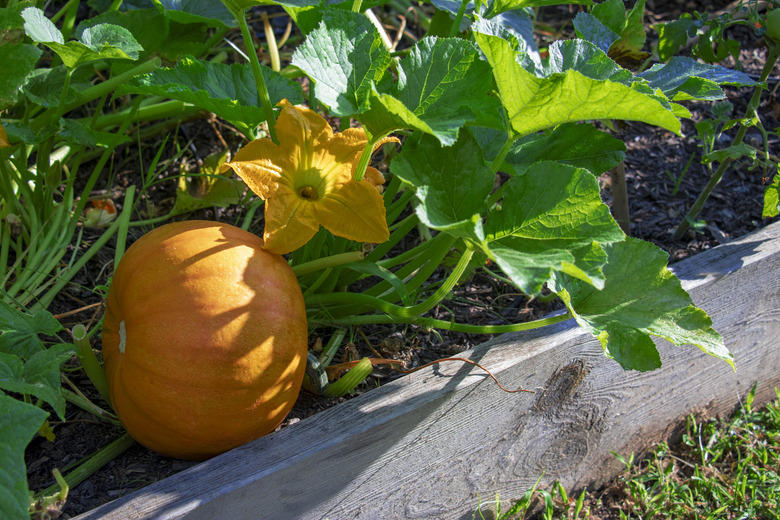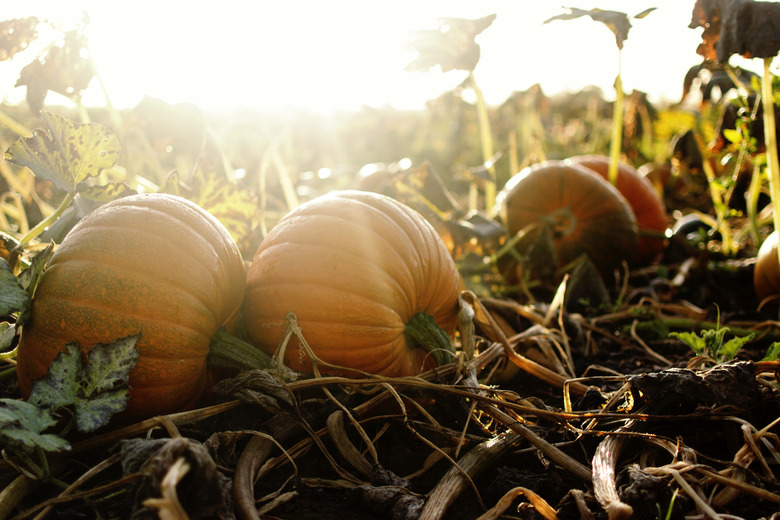How To Grow Pumpkins
We may receive a commission on purchases made from links.
Pumpkin plants (Cucurbita spp.) can make a great addition to a garden, whether they'll be grown for a holiday recipe or carved in the fall to make holiday decorations. Most of these plants have long vines, but the pumpkins themselves come in a wide range of cultivars as well as some colors outside of the traditional orange. Pumpkins are fairly easy to grow and can be added to a garden plan if desired. For the most part, this is a low-maintenance plant.
Large cultivars make great Halloween pumpkins since they are easy to carve and are traditional-looking. Those that are grown for pie tend to be sweeter with more flesh, such as a sugar pumpkin. All of the pumpkin plants are members of the Cucurbitaceae family, which also includes squash, cucumbers, and melons.
Best Uses for Pumpkins
Best Uses for Pumpkins
Pumpkins are a very popular plant, used for both ornamentation and food. Traditional Halloween pumpkins are wound tightly into the fall tradition in the United States, and they are carved and arranged as decor for the fall season. Thanksgiving finds pumpkin pie on many tables, and gardeners also enjoy making other baked goods and soups from this fresh, versatile fruit. In addition, many people enjoy scooping out the seeds of a pumpkin and toasting them in the oven. Pumpkin seeds make a great snack, or they can be added to a salad or meal for interest.
Most pumpkin cultivars require a lot of room to grow, as the pumpkin vines take up quite a bit of space. For example, many of the vine pumpkins will need up to 100 square feet to grow. That said, there are also miniature cultivars that can be trained on a trellis and some that will do well in large pots or raised beds. It's even possible to grow giant pumpkins. Be sure to do a little research and match the growth pattern of the pumpkin to the area that is available in the garden or yard. There are plenty from which to choose.
Starting Pumpkins From Seed
Starting Pumpkins From Seed
Purchase pumpkin seeds from a reputable nursery or order them online, and sow them in the ground when there is no risk of frost in the spring. Sow the seeds at a depth of 1 inch or less, following the directions for the specific cultivar chosen. Seeds sprout quickly, but be careful not to overwater, as that can cause them to rot. It is better to cover them with soil and give them a good soaking until the plant emerges from the soil.
Starting Pumpkins From a Seedling
Starting Pumpkins From a Seedling
It can be a good idea to start pumpkins indoors as well to give them a little more resilience. This can be especially helpful in colder climates where the ground doesn't warm quickly in the spring. Transplant them when they get to be about 3 inches tall.
The spacing of plants and seeds will depend in large part on the cultivar grown. Seed packets will have directions, but as a general guideline, pumpkins on the vine will need 5 to 6 feet of space between them and 10 to 15 feet between rows. Bush-type cultivars can be tightened up a bit, so space around 3 feet apart with 4 to 6 feet between rows. Miniature pumpkins can be spaced 2 feet apart with 6 to 8 feet between rows.
When growing pumpkin plants, don't trim the vines — just let them grow naturally. In addition, don't worry if the plant has flowers that bloom and drop off. These are the male flowers, and that is normal for their growth. The purpose of these flowers is to attract bees for pollination. The female flowers have small fruits at the base of the flowers, and it is from these that the pumpkins will eventually grow. If any row covers are being used, they will need to be removed once flowers appear so that bees have access to do their job.
If you are growing a crop of pumpkins each year, rotate them to another area of the yard with fresh soil every three or four years. This reduces the risk of both nematodes (roundworms) and certain types of fungal pathogens. Make sure not to plant other members of the Cucurbitaceae family in the same garden plot, though, as they all are susceptible.
In What Zone Do Pumpkins Grow Best?
In What Zone Do Pumpkins Grow Best?
Pumpkins grow best as annuals in USDA plant hardiness zones 3 through 11. They can be grown outside of these areas, but care must be taken to protect them from cold weather or from very long stretches of heat. Starting the plants indoors as seedlings in colder climates can be helpful.
When Should You Plant Pumpkins?
When Should You Plant Pumpkins?
If you are planting for a Halloween harvest, choose a cultivar that will mature in line with your climate. Seed packets will state the growing time; just count back from the holiday to find the right one. When you are growing for food purposes, find a good time window between spring and fall frosts that will minimize the coldest periods while still allowing the pumpkin plant enough time to mature. Most pumpkins take a long time to grow, with many coming in somewhere around the 100-day mark.
Pumpkins are not very cold-tolerant, which is why they need to be grown far from the frost dates in each region. For those living in the North, this probably means planting them sometime in May once the ground is not too cold. Those in warmer climates such as the South can put in these plants later, around early July.
If plants are already outdoors and a freeze is expected, use row covers or even old blankets to help shield the pumpkins from the cold. Keep in mind that plastic is not a good material to use since it develops moisture underneath, which can actually add to the problem.
Soil, Sunlight and Water Recommendations for Pumpkins
Soil, Sunlight and Water Recommendations for Pumpkins
Pumpkins do best in fertile, well-draining soil that isn't too compacted. Select a section of the garden that is in full sun. Since most pumpkin patch areas tend to be on the large side, preparing soil can be a bit labor-intensive. Loosen the soil and work in a mixture of compost and fertilizer, according to soil-test results, to make sure there are plenty of nutrients. Many gardeners also like to mound the soil where the seeds or seedlings will be planted as a way to help heat the soil in the beginning of the growth period in spring. This works especially well for colder climates, but it also helps with drainage.
Pumpkins are referred to by many as "hungry" plants. This means they require a lot of nourishment to grow well, which means healthy, fertile soil and a lot of water. Aim for an inch or so of water weekly and don't be fooled by dry-looking vines. That's a normal part of the growth cycle, and it can trick home gardeners into overwatering, which can cause rot. Mulch helps to cut down on weeds and to hold in moisture. Fertilize on a regular schedule, such as weekly or every two weeks, to make sure the pumpkins are well-nourished.
How to Harvest Pumpkins
How to Harvest Pumpkins
Pumpkins are ready to harvest when the rind becomes hard, and the color changes to a deep, even shade of the mature coloring. To be sure, give the rind a solid thump and listen for a hollow sound. Handle them gently so as not to bruise them and cut the stem with a sharp knife at about 4 inches. Keeping the stem on is important, as it helps preserve the fruits.
Once harvested, many pumpkins benefit from being set outside in the sun to cure for a week. Afterward, store them in a dry area that is around 50 degrees. Also, be sure to clean up all your vines once the pumpkins have been harvested to reduce the chances of any disease getting into the soil.
Common Pests and Other Problems for Pumpkins
Common Pests and Other Problems for Pumpkins
Cucumber beetles are typically one of the most prevalent pests when it comes to pumpkins and squash. Give young plants the advantage by using row covers to protect them from these and other insects when they are at their most vulnerable. When the plant begins to flower, however, these will need to be removed. Pumpkins need to be pollinated, which means bees and other friendly insects will need to have access to the flowers. Squash bugs and squash borers are also problematic, and all of these insects are at their worst in the late summer.
Squash borers are moth larvae, and they are especially damaging to squash and pumpkin plants. These insects dig into the stem of the plant and either harm or kill the pumpkins. It's difficult to spot these pests before the plant begins to wilt, and the larvae are already inside. They can be cut out, but it may kill the plant. Choose cultivars that are resistant to this pest and that will grow well in your climate. Also, once plants in the garden have had a problem with these insects, be sure to do a thorough cleanup to reduce their numbers for the following season.
Common Diseases for Pumpkins
Common Diseases for Pumpkins
Since pumpkins sit directly on the ground, they can have some moisture-related problems. Some gardeners like to put a piece of cardboard underneath pumpkins to help reduce direct contact with the soil. This helps reduce moisture and prevents the pumpkin from getting full of mud and dirt as well.
Downy mildew is one of the issues that pumpkins can face. Look for oddly shaped yellow lesions on the leaves of the plant and check leaf undersides for fuzz. Try to detect this problem early and treat with a fungicide to eliminate it if it is found. Powdery mildew can sometimes develop as well, and it can also be eliminated with fungicide. It looks like white powder on the leaves of the plant.


